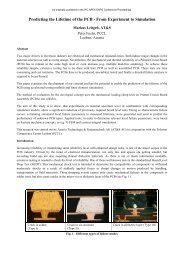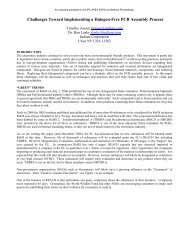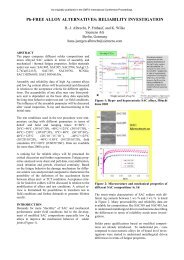Double Reflow-Induced Brittle Interfacial Failures in ... - IPC Outlook
Double Reflow-Induced Brittle Interfacial Failures in ... - IPC Outlook
Double Reflow-Induced Brittle Interfacial Failures in ... - IPC Outlook
- No tags were found...
You also want an ePaper? Increase the reach of your titles
YUMPU automatically turns print PDFs into web optimized ePapers that Google loves.
To draw a dist<strong>in</strong>ction between the de-wet and brittle fracture modes, the solder jo<strong>in</strong>t separation surfaces (<strong>in</strong>terfaces) must beanalyzed carefully. In addition to the total separation shown <strong>in</strong> the T20 solder jo<strong>in</strong>t, the three adjacent balls P20, R20 andU20 shown <strong>in</strong> Figure 9 exhibit similar but partial separation of the solder ball from the Ni-Sn IMC. At first glance, theseparations marked by the dashed yellow l<strong>in</strong>es <strong>in</strong> Figure 9 look like the solder jo<strong>in</strong>t de-wett<strong>in</strong>g failures. However theseparated areas marked by the dashed red l<strong>in</strong>es <strong>in</strong> Figure 9, show clear <strong>in</strong>dications of crack<strong>in</strong>g or fractur<strong>in</strong>g rather than dewett<strong>in</strong>g.Figure 9 - Magnified cross section, 1000X, of PCBA, Component A, solder balls P-20, R-20, and U-20.It is assumed that once Component A was attached to the PCBA dur<strong>in</strong>g the first reflow process there was a good physical andmetallurgical connection of solder balls to the PCB and package bond pads. Dur<strong>in</strong>g the subsequent second side reflowoperation, the solder jo<strong>in</strong>ts previously formed on Component A are subjected to an <strong>in</strong>creas<strong>in</strong>g thermal stress signature. It isreasonable to expect the mechanical strength of those solder jo<strong>in</strong>t <strong>in</strong>terconnections to decrease as the temperature <strong>in</strong>creases.Concurrently, stress and stra<strong>in</strong> are <strong>in</strong>duced <strong>in</strong> the solder jo<strong>in</strong>ts due to the mismatch <strong>in</strong> coefficient of thermal expansion (CTE)between the composite structures of Component A and the PCB lam<strong>in</strong>ate. The stress <strong>in</strong> the jo<strong>in</strong>ts could be exacerbated byany warpage <strong>in</strong> either the component or the PCB. If these stresses exceed the tensile strength of the solder jo<strong>in</strong>t, fracture willoccur along the weakest <strong>in</strong>terface. At higher temperatures near-reflow, the weakest l<strong>in</strong>k typically is the IMC/solder <strong>in</strong>terfaceas <strong>in</strong>dicated <strong>in</strong> Figure 8. Based on those cross sections, it is reasonable to conclude that fracture results from the <strong>in</strong>creas<strong>in</strong>gstress on the component solder jo<strong>in</strong>ts dur<strong>in</strong>g the second reflow process due to a comb<strong>in</strong>ation of CTE mismatch and thecomponent and PCB warpage.There are two possible scenarios to consider. In the first scenario, the solder jo<strong>in</strong>t could be fractur<strong>in</strong>g dur<strong>in</strong>g the reflow rampup. This could be happen<strong>in</strong>g at any po<strong>in</strong>t before the solder beg<strong>in</strong>s to melt. Stress of course cannot be transferred to the IMC<strong>in</strong>terface once the solder has melted. Although vapor phase reflow is rapid and provides more uniform heat<strong>in</strong>g than forcedconvection IR reflow, temperature gradients will exist across components. Solder jo<strong>in</strong>ts <strong>in</strong> the outer rows of the perimeterarray are expected to reach the solder melt<strong>in</strong>g po<strong>in</strong>t a f<strong>in</strong>ite time before the <strong>in</strong>ner rows. The differential melt<strong>in</strong>g may generateadditional local stresses that could add to the any global stresses generated by differences <strong>in</strong> component and PCB CTE andwarpage. Once the balls on the perimeter of the package melt, all the stress <strong>in</strong> the package is transferred to <strong>in</strong>ner unmeltedballs, which could result <strong>in</strong> fracture at those sites.
















